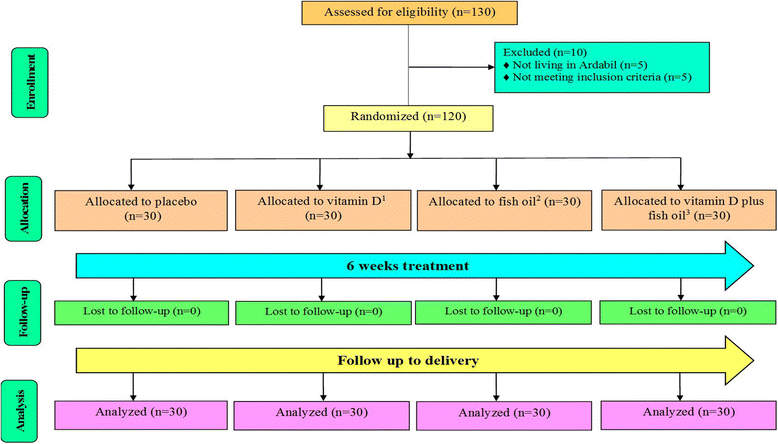The effects of vitamin D and omega-3 fatty acids co-supplementation on biomarkers of inflammation, oxidative stress and pregnancy outcomes in patients with gestational diabetes
- PMID: 29299042
- PMCID: PMC5745759
- DOI: 10.1186/s12986-017-0236-9
The effects of vitamin D and omega-3 fatty acids co-supplementation on biomarkers of inflammation, oxidative stress and pregnancy outcomes in patients with gestational diabetes
Abstract
Background: This study was carried out to determine the effects of vitamin D and omega-3 fatty acids co- supplementation on biomarkers of inflammation, oxidative stress and pregnancy outcomes in gestational diabetes (GDM) patients.
Methods: This randomized, double-blind, placebo-controlled trial was conducted among 120 GDM women. Participants were randomly divided into four groups to receive: 1) 1000 mg omega-3 fatty acids containing 180 mg eicosapentaenoic acid (EPA) and 120 mg docosahexaenoic acid (DHA) twice a day + vitamin D placebo (n = 30); 2) 50,000 IU vitamin D every 2 weeks + omega-3 fatty acids placebo (n = 30); 3) 50,000 IU vitamin D every 2 weeks + 1000 mg omega-3 fatty acids twice a day (n = 30) and 4) vitamin D placebo + omega-3 fatty acids placebo (n = 30) for 6 weeks.
Results: Subjects who received vitamin D plus omega-3 fatty acids supplements compared with vitamin D, omega-3 fatty acids and placebo had significantly decreased high-sensitivity C-reactive protein (-2.0 ± 3.3 vs. -0.8 ± 4.4, -1.3 ± 2.4 and +0.9 ± 2.7 mg/L, respectively, P = 0.008), malondialdehyde (-0.5 ± 0.5 vs. -0.2 ± 0.5, -0.3 ± 0.9 and +0.5 ± 1.4 μmol/L, respectively, P < 0.001), and increased total antioxidant capacity (+92.1 ± 70.1 vs. +55.1 ± 123.6, +88.4 ± 95.2 and +1.0 ± 90.8 mmol/L, respectively, P = 0.001) and glutathione (+95.7 ± 86.7 vs. +23.0 ± 62.3, +30.0 ± 66.5 and -7.8 ± 126.5 μmol/L, respectively, P = 0.001). In addition, vitamin D and omega-3 fatty acids co-supplementation, compared with vitamin D, omega-3 fatty acids and placebo, resulted in lower incidences of newborns' hyperbilirubinemiain (P = 0.037) and newborns' hospitalization (P = 0.037).
Conclusion: Overall, vitamin D and omega-3 fatty acids co-supplementation for 6 weeks among GDM women had beneficial effects on some biomarkers of inflammation, oxidative stress and pregnancy outcomes.
Keywords: Gestational diabetes; Omega-3 fatty acids; Pregnancy outcomes; Supplementation; Vitamin D.
Conflict of interest statement
All procedures performed in studies involving human participants were in accordance with the ethical standards of the institutional and national research committee and with the 1964 Helsinki declaration and its later amendments.Not applicable.The authors declare no competing interest.Springer Nature remains neutral with regard to jurisdictional claims in published maps and institutional affiliations.
Figures

References
-
- Blickstein I, Doyev R, Trojner Bregar A, Brzan Simenc G, Verdenik I, Tul N. The effect of gestational diabetes, pre-gravid maternal obesity, and their combination ('diabesity') on outcomes of singleton gestations. J Matern Fetal Neonatal Med. 2017:1–4. - PubMed
LinkOut - more resources
Full Text Sources
Other Literature Sources
Research Materials

